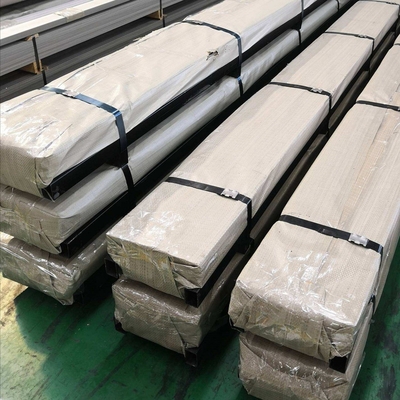|
General Corrosion The Type 321 alloy offers similar resistance to general, overall corrosion as the unstabilized chromium nickel Type 304. Heating for long periods of time in the chromium carbide precipitation range may affect the general resistance of Type 321 in corrosive media.
Intergranular Corrosion
Type 321 has been developed for applications where the unstabilized chromium-nickel steels, such as Type 304 would be susceptible to intergranular corrosion.
When the unstabilized chromium-nickel steels are held in or slowly cooled through the range of 800 to 1500° F (427 to 816° C), chromium carbide is precipitated at the grain boundaries. In the presence of certain strongly corrosive media, these grain boundaries are preferentially attached, a general weakening of the metal results, and a complete disintegration may occur.
Organic media or weakly corrosive aqueous agents, mil and other dairy products, or atmospheric conditions rarely produce intergranular corrosion even when large amounts of precipitated carbides are present. When thin gauge material is welded the time in the temperature range of 800 to 1500° F (427 to 816° C) is so short that with most corroding media the unstabilized type material is generally satisfactory. The extent to which carbide precipitation may be harmful depends upon the length of time the alloy was exposed to 800 to 1500° F (427 to 816° C) and upon the corrosive environment. Even the longer heating times involved in welding heavy gauges are not harmful to the unstabilized “L” grade alloys where the carbon content is kept to low amounts of 0.03% or less.
In general, Type 321 is used for heavy welded equipment which is operated between 800 to 1500° F (427 to 816° C) or slowly cooled through this range. Experience gained in a wide range of service conditions has provided sufficient data to generally predict the possibility of intergranular attach in most applications. Please review the comments under the HEAT TREATMENT section.
Stress Corrosion Cracking
The Type 321 austenitic stainless steel is susceptible to stress corrosion cracking (SCC) in halides similar to Type 304 stainless steel. This results because of their similarity in nickel content. Conditions which cause SCC are: (1) presence of halide ion (generally chloride), (2) residual tensile stresses, and (3) environmental temperatures in excess of about 120° F (49° C). Stresses may result from cold deformation during forming operations, or from thermal cycles encountered during welding operations. Stress levels may be reduced by annealing or stress-relieving heat treatments following cold deformation. Type 321 is a good choice for service in the stress-relieved condition in environments which might otherwise cause intergranular corrosion for unstabilized alloys.
Type 321 is particularly useful under conditions which cause polythionic acid stress corrosion of non-stabilized austenitic stainless steels such as Type 304. Exposure of non-stabilized austenitic stainless steel to temperatures in the sensitizing range will cause the precipitation of chromium carbides at grain boundaries. On cooling to room temperature in a sulfide-containing environment, the sulfide (often hydrogen sulfide) reacts with moisture and oxygen to form polythionic acids which attach the sensitized grain boundaries. Under conditions of stress, intergranular cracks form. Polythionic acid SCC has occurred n oil refinery environments where sulfides are common. The stabilized Type 321 alloy offers a solution to polythionic acids SCC by resisting sensitization during elevated temperature service. For optimum resistance, these alloys should be used in the thermally stabilized condition if service related conditions may result in sensitization.
Pitting/Crevice Corrosion
The resistance of the stabilized Type 321 alloy to pitting and crevice corrosion in the presence of chloride ion is similar to that of Type 304 or Type 304L stainless steels because of similar chromium content. Generally, 100 ppm chloride in aqueous environments is considered to be the limit for both the unstabilized and the stabilized alloys, particularly if crevices are present. Higher levels of chloride ion might cause crevice corrosion and pitting. For more severe conditions of higher chloride level, lower pH and/or higher temperature, alloys with molybdenum, such as Type 316, should be considered. The stabilized Type 321 alloy passes the 100 hour, 5% neutral salt spray test (ASTM-B-117) with no rusting or staining of samples. However, exposure of these alloys to salt mists from the ocean would be expected to cause pitting and crevice corrosion accompanied by severe discoloration. The Type 321 alloy is not recommended for exposure to marine environments.
|

 Your message must be between 20-3,000 characters!
Your message must be between 20-3,000 characters! Please check your E-mail!
Please check your E-mail!  Your message must be between 20-3,000 characters!
Your message must be between 20-3,000 characters! Please check your E-mail!
Please check your E-mail! 






